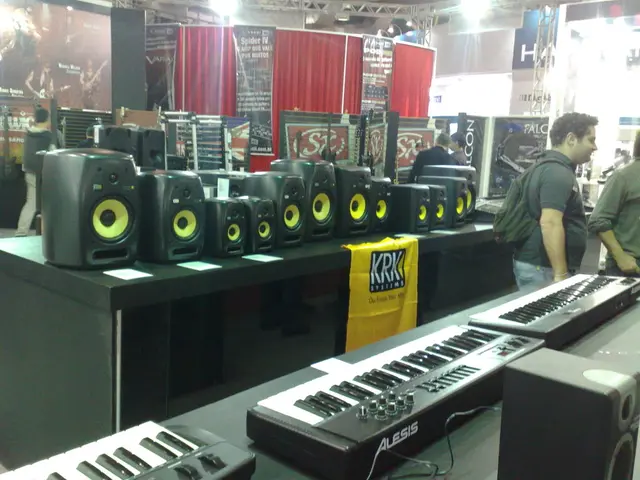Intensive firefighting assistance through Airbus technological solutions
Airbus Defence and Space is making significant strides in the realm of crisis management, developing a cutting-edge crisis management system (CMS) to tackle emergencies such as wildfires and floods more effectively. This innovative system is set to revolutionise disaster response and management.
Helicopters Optimised for Firefighting and Rescue
At the heart of Airbus' firefighting efforts are a fleet of versatile helicopters, including the H225, H145, and H125. These aircraft are widely employed by fire departments worldwide, including the Tokyo Fire Department and units in the United States, for aerial firefighting, search and rescue, emergency medical response, and disaster recovery.
The H225, equipped with a belly-mounted tank system, rapid detection technology, autopilot, and long-range capabilities, offers precision and endurance in diverse operational conditions. Meanwhile, the H145 and H125 are valued for their firefighting technology and public safety mission support.
Satellite-Based Air Quality and Environmental Monitoring
Airbus is leveraging satellite technology to monitor air quality globally, providing vital data to identify environmental hazards such as pollution or smoke from wildfires. This satellite data supports timely responses and scientific tracking of natural phenomena affecting fire risks and climate, indirectly aiding firefighting strategies and resource deployment.
Advanced Communications and Support Systems
Airbus offers communications and operational support solutions that enhance coordination during emergency missions. Their global presence includes training academies and Maintenance, Repair, and Overhaul (MRO) centers to maintain helicopter readiness and pilot proficiency, contributing to sustained firefighting capabilities.
Simulators and Training Development
In a bid to improve pilot skills in managing wildfire operations and emergency scenarios safely and effectively, Airbus collaborates on enhanced firefighting pilot simulators.
A400M Roll-on/Roll-off Firefighting Kit
The A400M aircraft is equipped with a roll-on/roll-off firefighting kit, which can be filled with water or retardant in less than 10 minutes using standard high-pressure pumps on the ground. Airbus Defence and Space conducted a flight test campaign for the A400M Roll-on/Roll-off firefighting prototype kit, which can drop 20,000 litres of retardant and create lines up to 400 metres long.
Water-Bombing Helicopters and Damage Assessment
Water-bombing helicopters, equipped with a flexible bucket or belly tank, can drop up to 4,000 L of water each time they fly over a fire. The H125 can drop up to 1,200 L with each pass. Airbus' Pleiades Neo satellites provide high-resolution imagery for detailed area damage assessment.
Improved Avionics, Automated Flight Features, and Interoperability
Improved avionics, automated flight features, and increased interoperability are key drivers for addressing firefighting challenges. The C295 multirole aircraft can be used to monitor fires, while the H215 helicopter, rugged, cost-efficient, and with a demonstrated capability in demanding conditions, can carry a large number of firefighters and has a 4,000-litre water discharge capacity.
Crisis Management System Integration
The new crisis management system integrates different data sources and links all components of crisis management, aiming to provide a unified, efficient response to emergencies. In the UK, 70% of mainland fire and rescue services rely on the digital solution SAFEcommand for critical incident information coordination. Airbus Defence and Space is working on a nationwide secure communication network to improve coordination between firefighters.
Airbus' professional communication application Agnet is used by several public safety organizations, providing real-time situational awareness and a common operating picture. The C295 aircraft has been used to drop fire extinguishing boxes, and a firefighting version is currently under development.
In conclusion, Airbus Defence and Space's contributions to firefighting missions extend beyond traditional means, integrating advanced rotary-wing aircraft with satellite monitoring and comprehensive training and support infrastructure to provide a robust, multi-domain contribution to firefighting missions worldwide. Night flights are becoming a new normal for Airbus helicopters, ensuring firefighting operations in all-weather conditions.
- As part of its environmental monitoring efforts, Airbus is utilizing satellite technology to gather data on air quality and detect pollution or smoke from wildfires, which subsequently aids in disaster response and scientific tracking of natural phenomena.
- To revolutionize the manufacturing industry, Airbus Defence and Space is developing a smart-home device, the A400M aircraft, featuring a roll-on/roll-off firefighting kit that can be filled with water or retardant quickly, enhancing its firefighting capabilities.
- In the field of casino-and-gambling, Airbus professional communication application Agnet is utilized by several public safety organizations to provide real-time situational awareness and a common operating picture during critical incidents.
- The integration of the crisis management system by Airbus Defence and Space is designed to link all components of crisis management, offering a unified, efficient response to emergencies, such as wildfires, and reducing the time required for damage assessment.
- Alongside the development of cutting-edge crisis management systems, Airbus is focusing on the finance sector, collaborating with banks and finance institutions to secure funds for the continued research and development of advanced firefighting technology, environmental-science innovations, and other essential industry initiatives.




